Effect of the Load Application Angle on the Compressive Behavior of Al Honeycomb under Combined Normal–Shear Stress
Abstract
:1. Introduction
2. Motivation and Novelties
3. Materials and Methods
3.1. Samples Preparation and Geometrical Characterization
3.2. Experimental Apparatus Setup
3.3. Validation of the Test Apparatus
4. Experimental Results
4.1. Normal Compression Tests (0°)
4.2. Combined Normal–Shear Tests (15°)
4.3. Combined Normal–Shear Tests (25°)
5. Results Analysis
5.1. Stress–Strain Curves at Different Load Application Angles
- (1)
- The pseudoelastic phase, in which the stress linearly increased with the strain; this stage was characterized by elastic instability in the samples loaded at 0° and plastic collapse up to peak stress;
- (2)
- The plateau phase, in which the stress was nearly constant (for 0° and 15°) and moderately decreasing (for 25°);
- (3)
- The densification phase, in which the stress showed a sharp increase due to the end of the plasticity of the honeycomb cell walls.
5.2. Cell Rotation Angle
6. Discussion
7. Conclusions and Future Outlook
- (1)
- Different deformation patterns were identified and correlated with the presence/absence of the shear component;
- (2)
- The stress–strain curves were found to be significantly affected by the deformation pattern;
- (3)
- The maximum peak stress, ascribable to the load instability, exhibited the maximum value for the 0° load application angle, while lower values could be found at 15° and 25°. In particular, the peak stress was reduced from 1.80 MPa at 0° to 1.04 MPa in the configuration at 15°, and 0.95 MPa at 25°;
- (4)
- The plateau region was quite similar in the tests performed at 0° and 15°, while showing a sharp decrease in the stress at 25°, as evidenced by the , equal to 0.98 for 0°, 0.93 for 15°, and 0.73 for 25°;
- (5)
- The stress–strain curves showed that the normal plateau stress decreased significantly with an increase in the load application angle;
- (6)
- The displacement corresponding to the start of densification in the combined compression (about 40 mm) was greater than that given in the normal compression (about 38 mm); the honeycomb could be compressed to a decreasing thickness in the out-of-the-plane direction under combined stress rather than uniaxial stress;
- (7)
- The shear stress abruptly achieved a maximum value, and after that, it decreased with an increasing displacement, and then there was a final peak due to friction once all the cells collapsed;
- (8)
- The absorbed energy increased from 0.67 at 0° to 0.72 at 15° and decreased again to 0.56 at 25°, due to the contribution of higher displacement, but at the same time, lower stress;
- (9)
- (10)
- The application of a shear stress component during operation, in addition to the normal compression, may result in a premature failure of the component, with a lower stress than expected.
Author Contributions
Funding
Institutional Review Board Statement
Informed Consent Statement
Data Availability Statement
Acknowledgments
Conflicts of Interest
References
- Galletti, G.G.; Vinquist, C.; Es-Said, O.S. Theoretical design and analysis of a honeycomb panel sandwich structure loaded in pure bending. Eng. Fail. Anal. 2008, 15, 555–562. [Google Scholar] [CrossRef]
- Ganilova, O.A.; Cartmell, M.P.; Kiley, A. Experimental investigation of the thermoelastic performance of an aerospace aluminium honeycomb composite panel. Compos. Struct. 2021, 257, 113159. [Google Scholar] [CrossRef]
- Liu, K.; Zong, S.; Wang, Z.; Hu, Z.; Wang, Z. Structural response of the U-type corrugated core sandwich panel used in the ship structures under the lateral quasi-static compression load. Mar. Struct. 2022, 84, 103198. [Google Scholar] [CrossRef]
- Savage, G. Development of penetration resistance in the survival cell of a Formula 1 racing car. Eng. Fail. Anal. 2010, 17, 116–127. [Google Scholar] [CrossRef]
- Gibson, L.J.; Ashby, M.F. Cellular Solids: Structure and Properties, 2nd ed.; Cambridge University Press: Cambridge, UK, 1999. [Google Scholar]
- Atkinson, R. Innovative uses for sandwich construction. Reinf. Plast. 1997, 41, 30–33. [Google Scholar]
- Feng, Y.; Qiu, H.; Gao, Y.; Zheng, H.; Tan, J. Creative design for sandwich structures: A review. Int. J. Adv. Robot. Syst. 2020, 17, 1729881420921327. [Google Scholar] [CrossRef]
- Han, T.S.; Ural, A.; Chen, C.S.; Zehnder, A.T.; Ingraffea, A.R.; Billington, S.L. Delamination buckling and propagation analysis of honeycomb panels using a cohesive element approach. Int. J. Fract. 2002, 115, 101–123. [Google Scholar] [CrossRef]
- Stanzack, M.; Fras, T.; Blanc, L.; Pawlowski, P.; Rusinek, A. Blast-induced compression of a thin-walled aluminum honeycomb structure-experiment and modeling. Metals 2019, 9, 1350. [Google Scholar] [CrossRef] [Green Version]
- Wilbert, A.; Yang, W.Y.; Kyriakides, S.; Flocari, J.F. Buckling and progressive crushing of laterally loaded honeycomb. Int. J. Sol. Struct. 2011, 48, 803–816. [Google Scholar] [CrossRef] [Green Version]
- Shi, G.; Wu, X.; Jiang, R.; Li, S. A particle reinforced gradient honeycomb sandwich panel for broadband insulation. Mathematics 2023, 11, 502. [Google Scholar] [CrossRef]
- Qiao, Y.; Peng, Y.; Cheng, Y.; Zhou, X.; Wang, F.; Li, F.; Wang, Q.; Yu, C.; Wang, H. Study on the cell magnification in out-of-plane compression simulations of aluminum honeycomb. Sustainability 2023, 15, 1882. [Google Scholar] [CrossRef]
- ASTM C365/365M-22; Standard Test Method for Flatwise Compressive Properties of Sandwich Cores. ASTM International: West Conshohocken, PA, USA, 2022.
- Hou, B.; Wang, Y.; Suna, T.F.; Liud, J.G.; Zhao, H. On the quasi-static and impact response of aluminum honeycomb under combined shear-compression. Int. J. Impact Eng. 2019, 131, 190–199. [Google Scholar] [CrossRef]
- Zhang, D.; Lu, G.; Ruan, D.; Fei, Q.; Duan, W. Quasi-static combined compression-shear crushing of honeycombs: An experimental study. Mater. Des. 2019, 167, 107632. [Google Scholar] [CrossRef]
- Hong, S.T.; Pan, J.; Tyan, T.; Prasad, P. Quasi-static crush behavior of aluminum honeycomb specimens under compression dominant combined loads. Int. J. Plast. 2006, 22, 73–109. [Google Scholar] [CrossRef]
- Costanza, G.; Ferrigno, S.; Tata, M.E. Static compression study of honeycomb panel. Met. Ital. 2021, 113, 13–21. [Google Scholar]
- CEL. Pannello Sandwich Compocel AL. Available online: https://www.cel.eu/img_ins/files/Compocel_AL_it_Rev_10.pdf (accessed on 10 June 2023).
- Duan, Y.; Liu, Z.; Zhao, X.; Hou, N.; Du, B.; Liu, H.; Zhao, Z.; Hou, B.; Li, Y.; Rabinsky, L.V. Crushing behavior of honeycomb vs. foam under combined shear-compression loading. Int. J. Impact Eng. 2020, 146, 103696. [Google Scholar] [CrossRef]
- Corigliano, P.; Palomba, G.; Crupi, V.; Garbatov, Y. Stress-strain assessment of honeycomb sandwich panel subjected to uniaxial compressive load. J. Mar. Sci. Eng. 2023, 11, 365. [Google Scholar] [CrossRef]
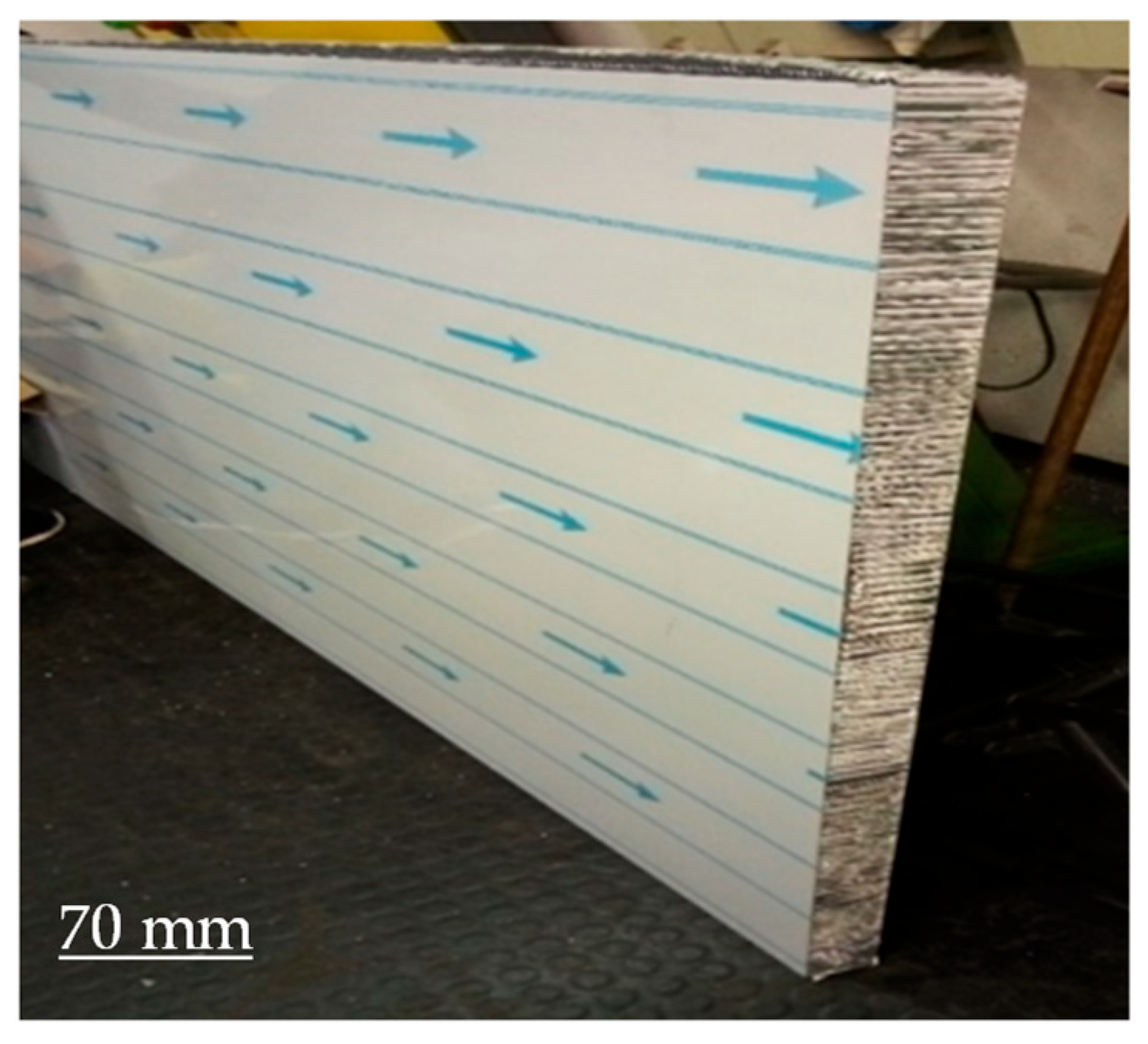


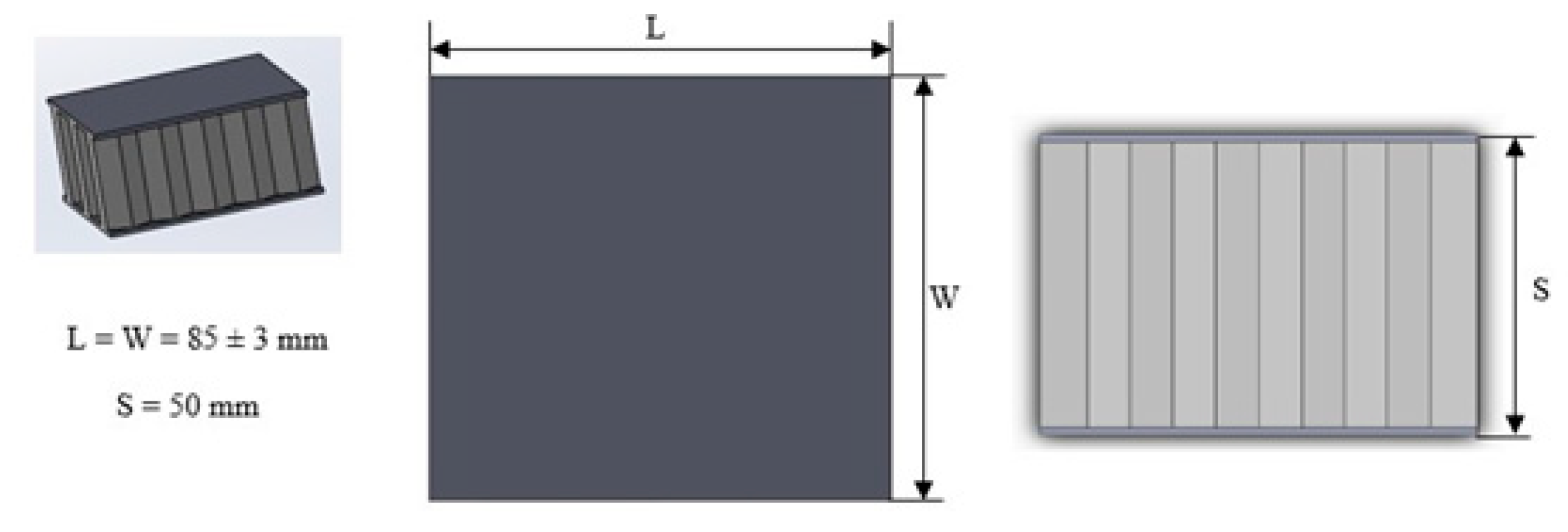
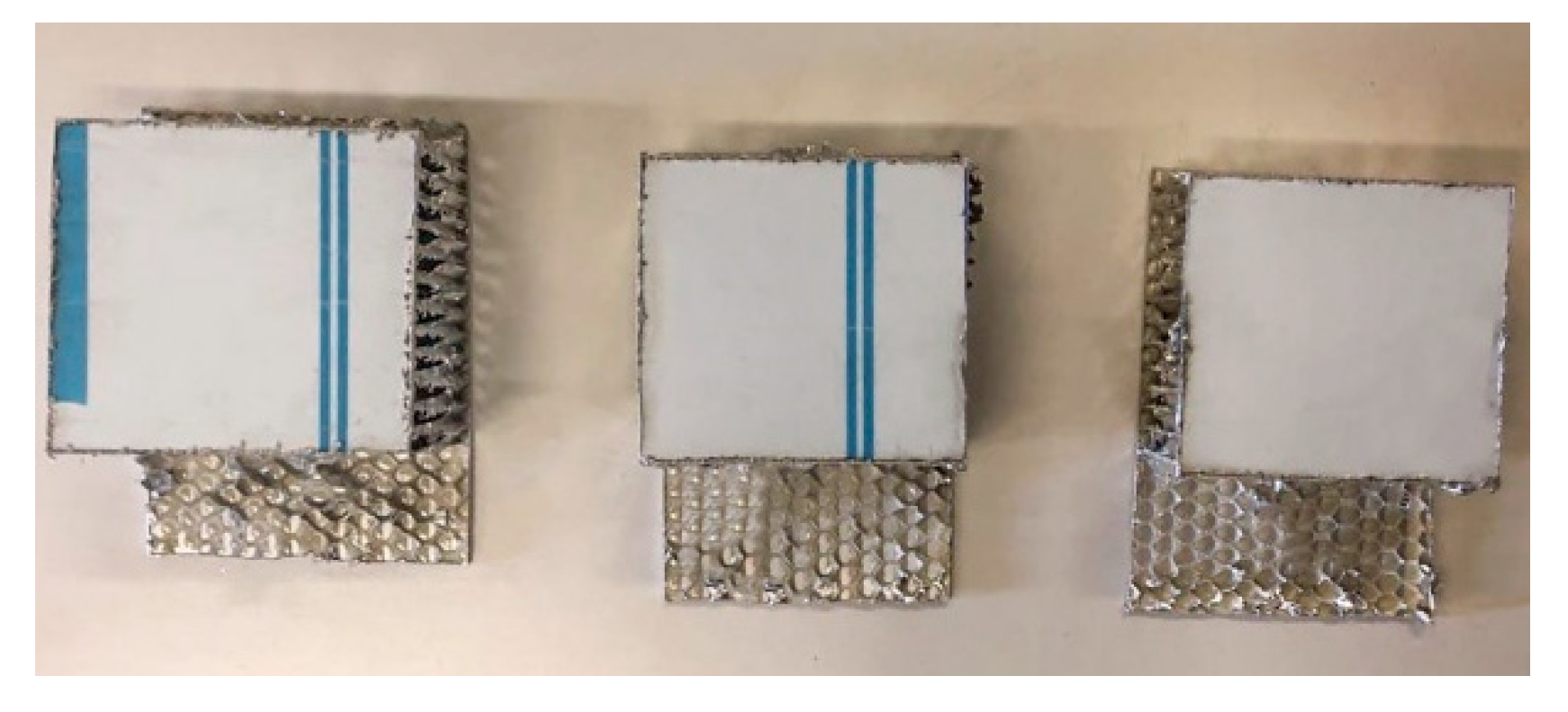




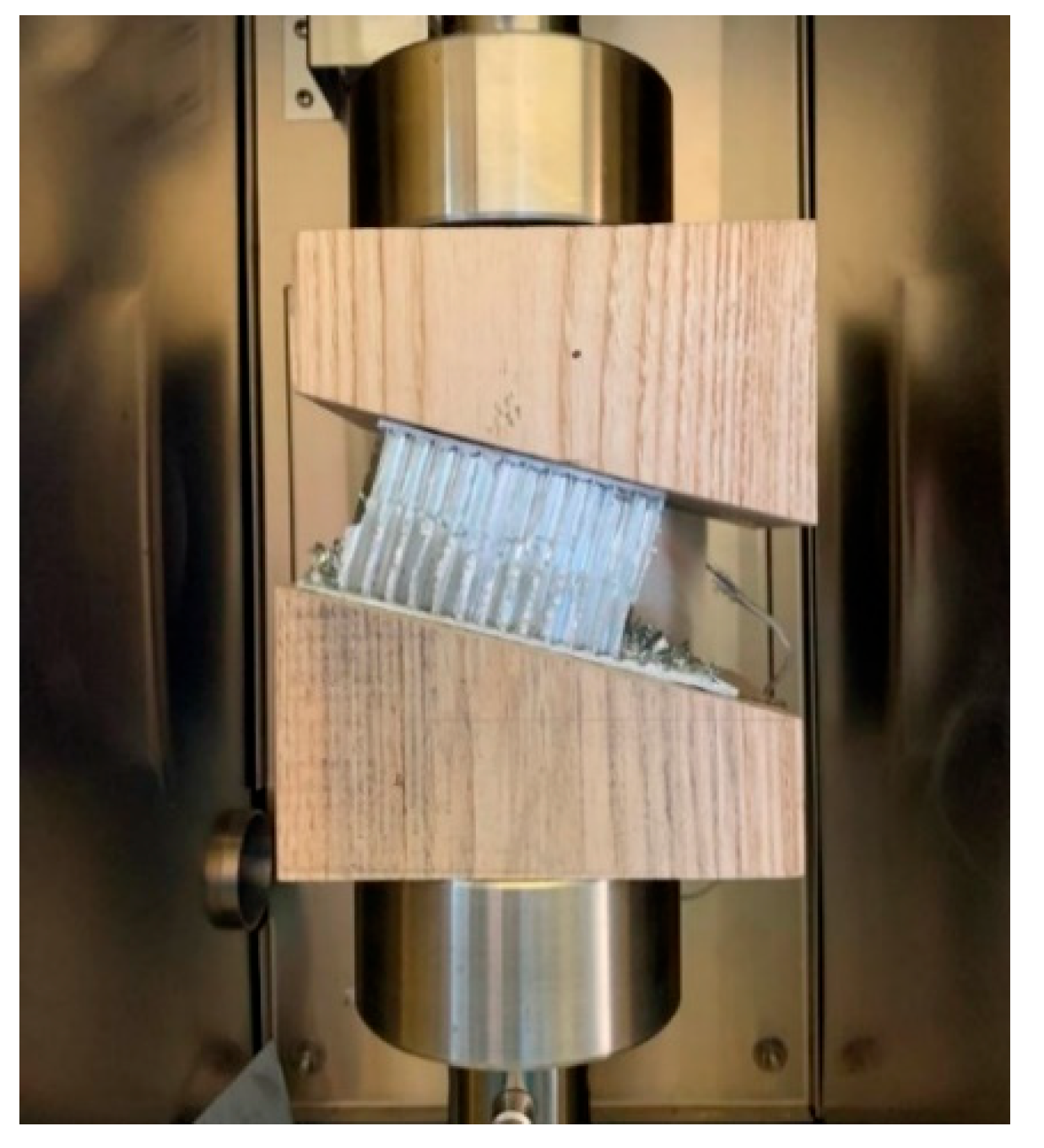

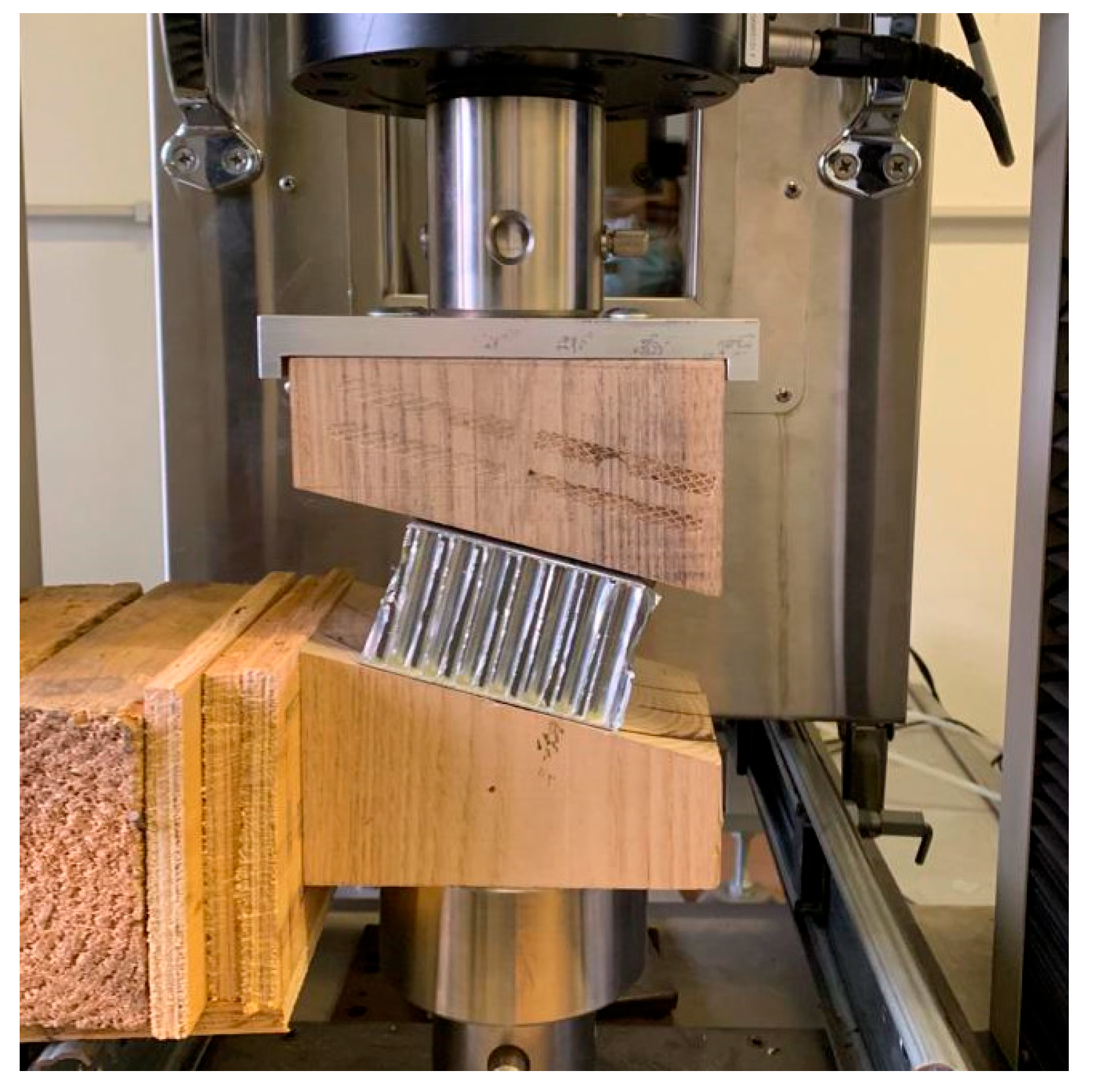
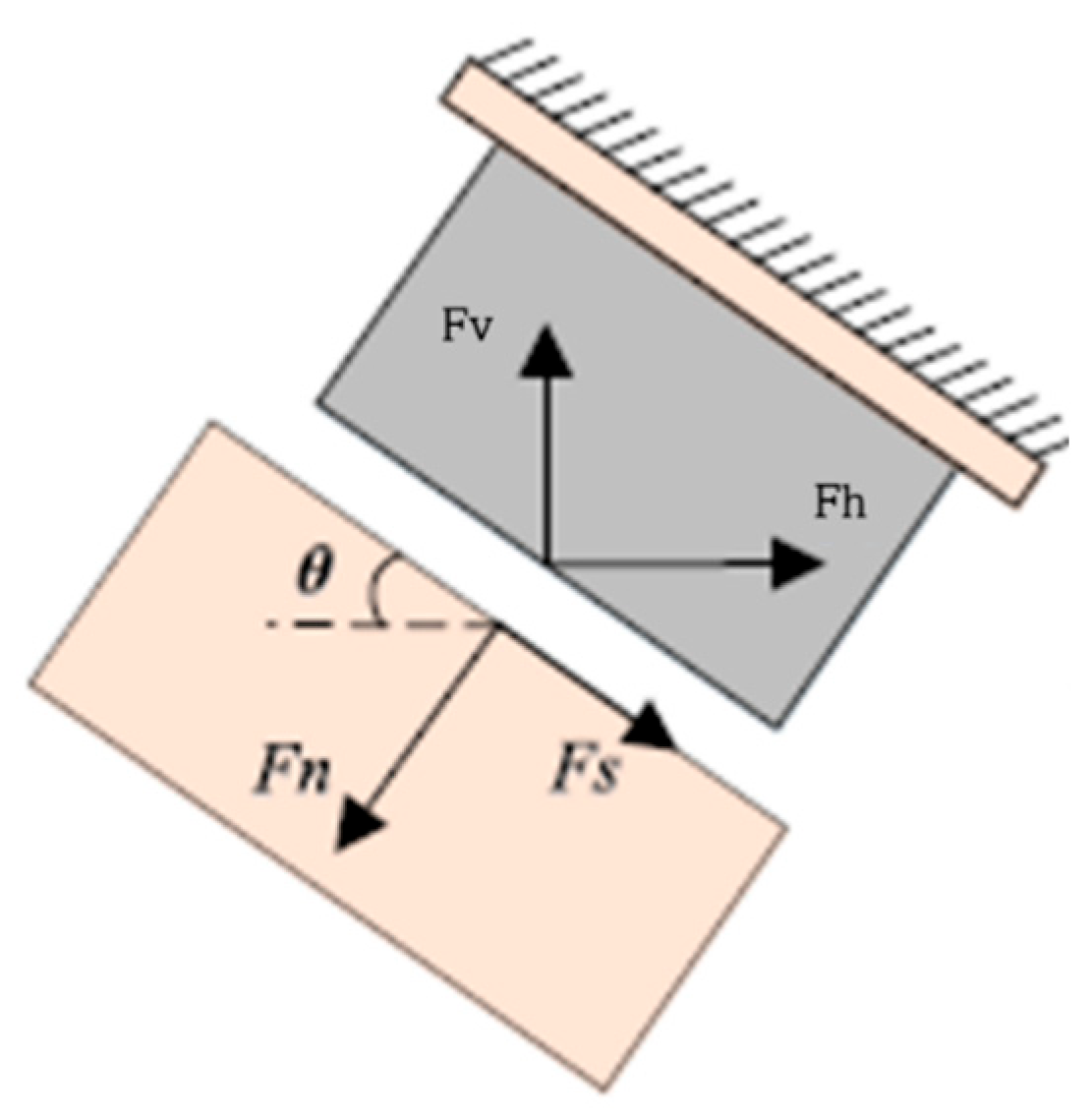

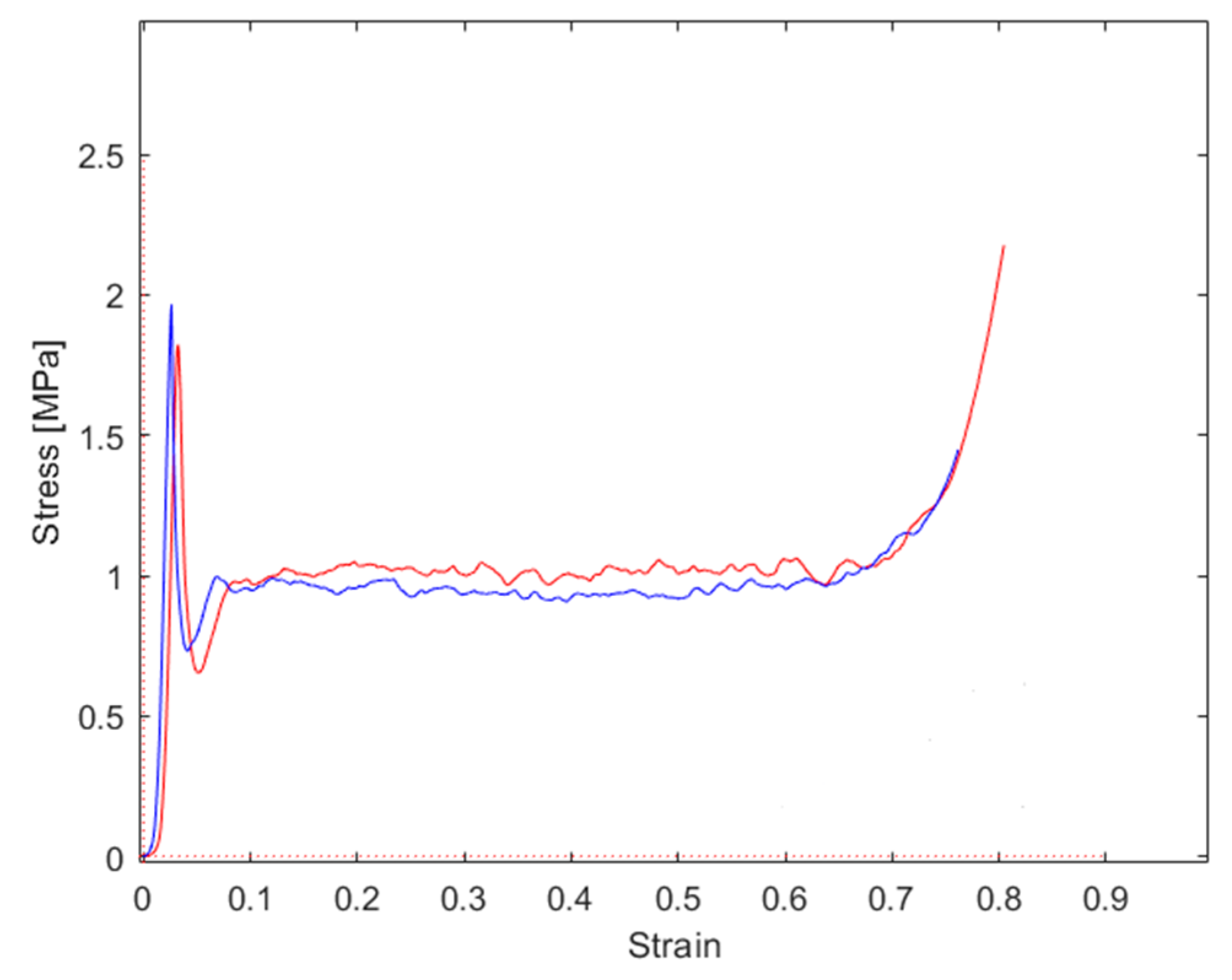

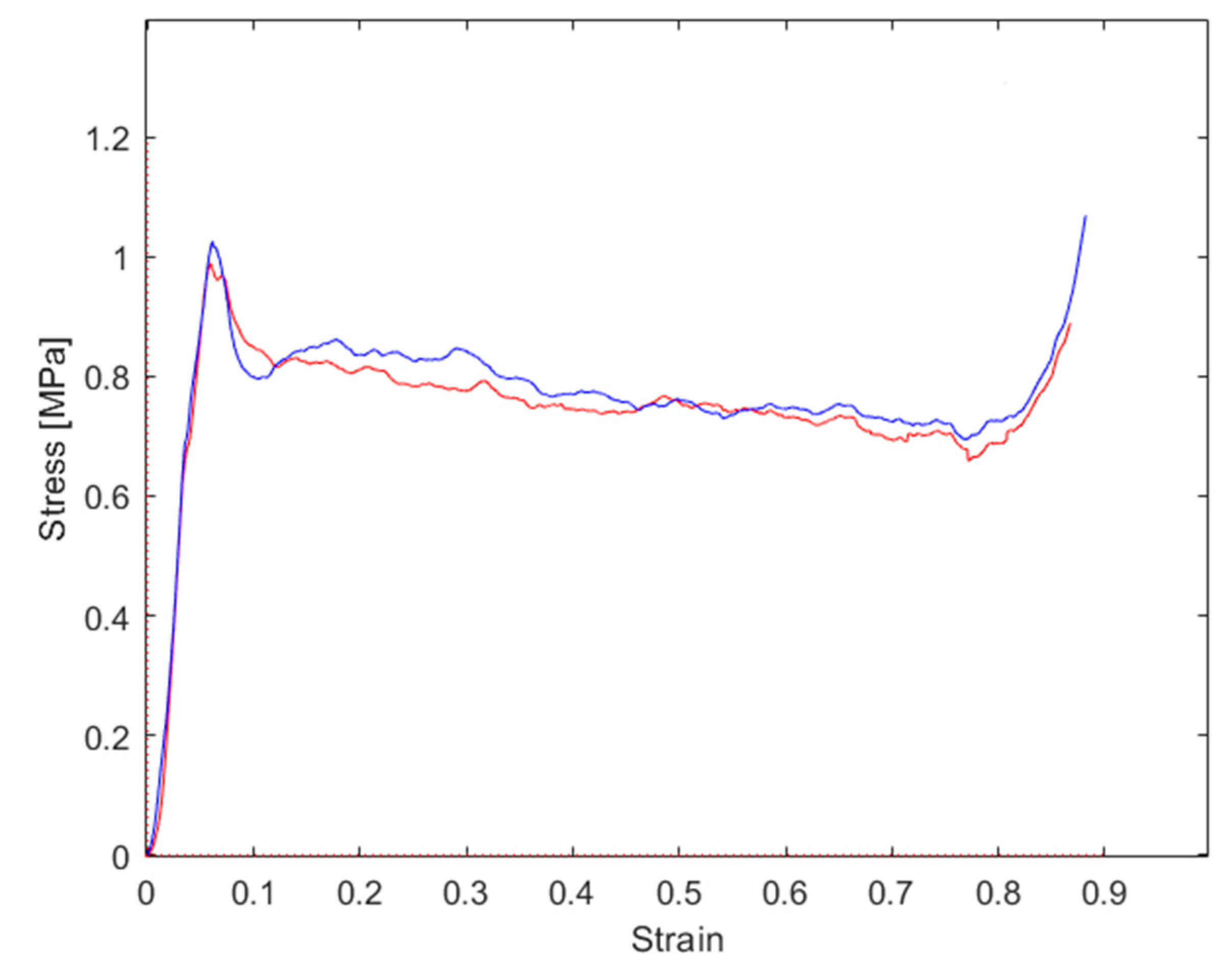
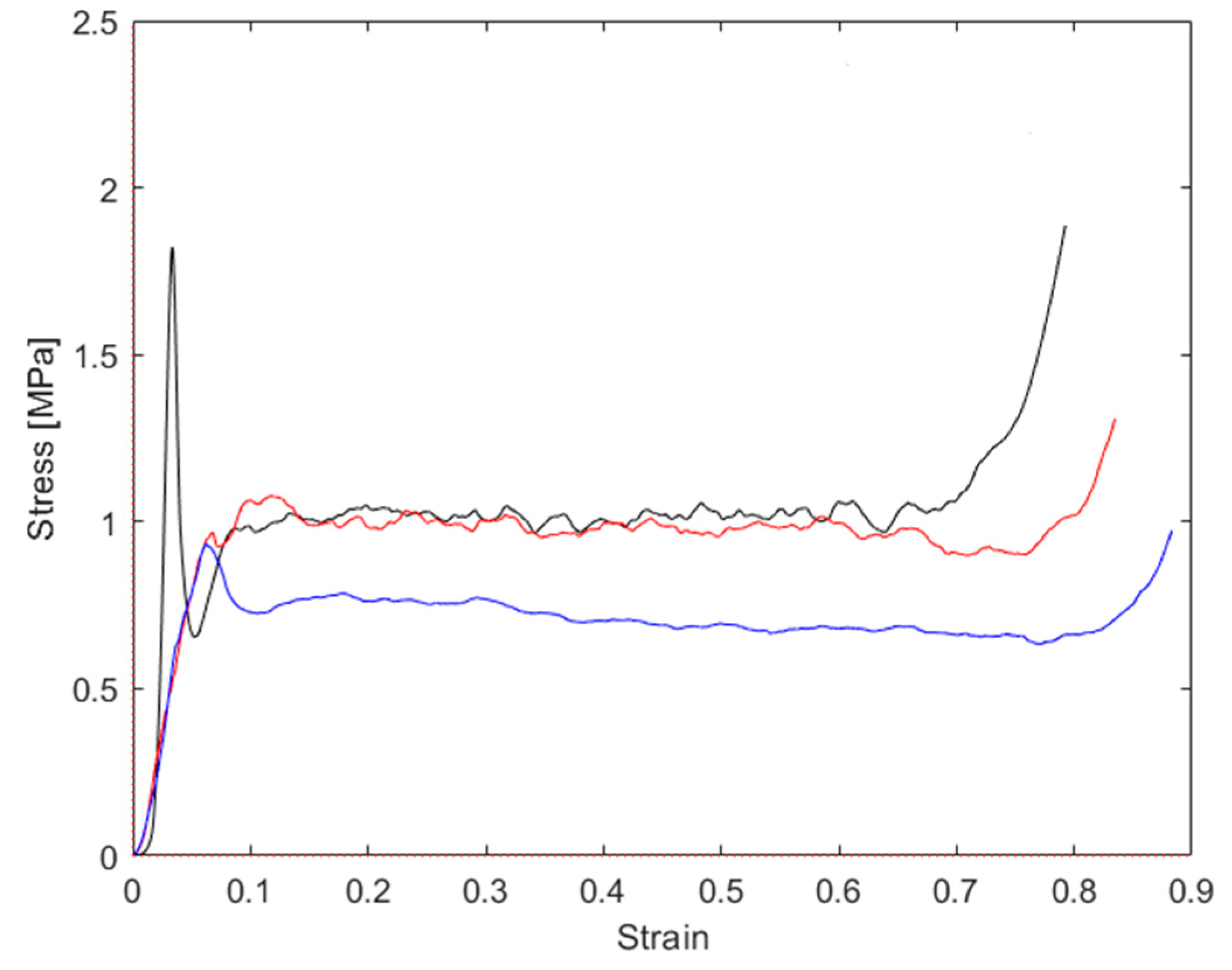

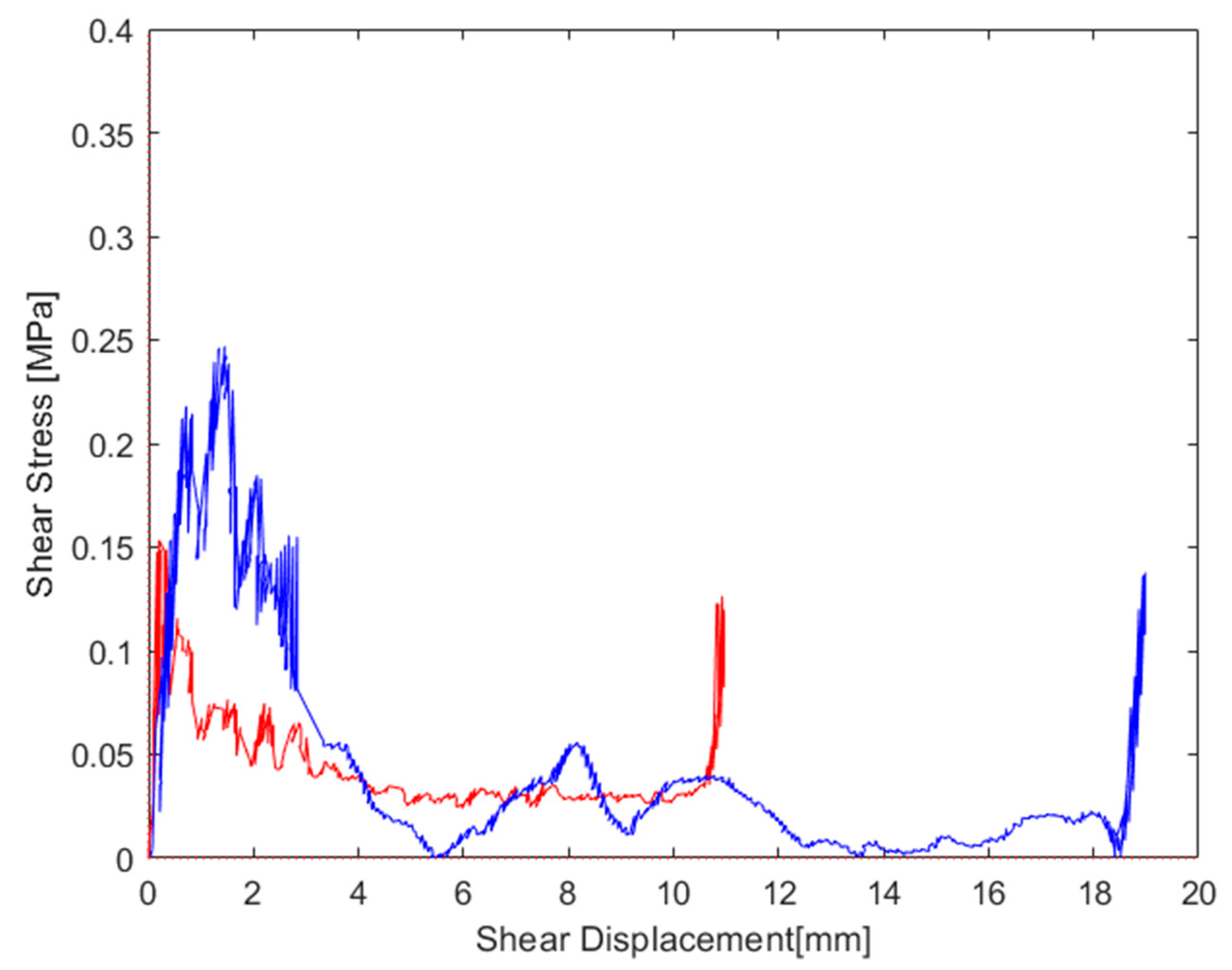
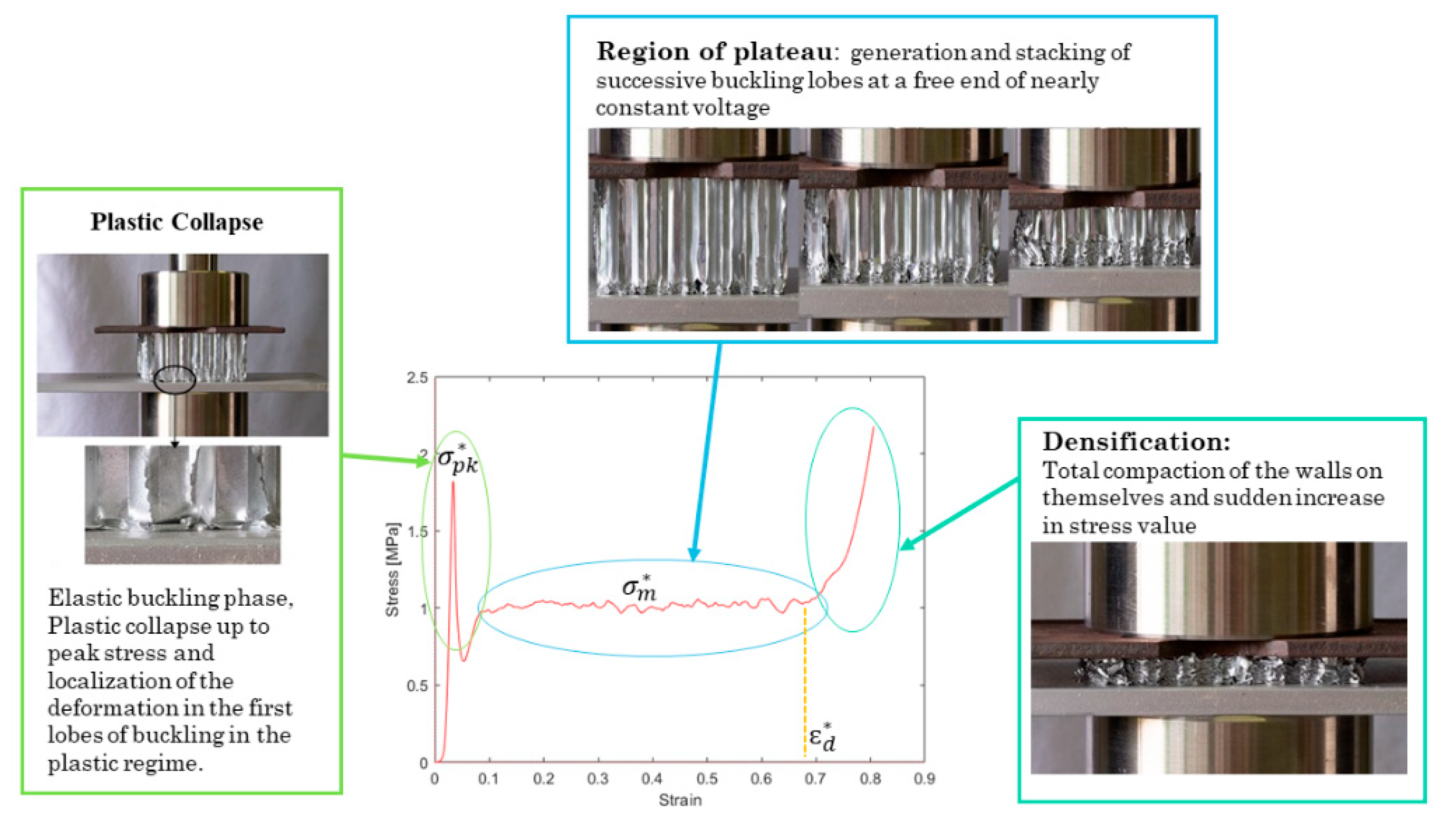
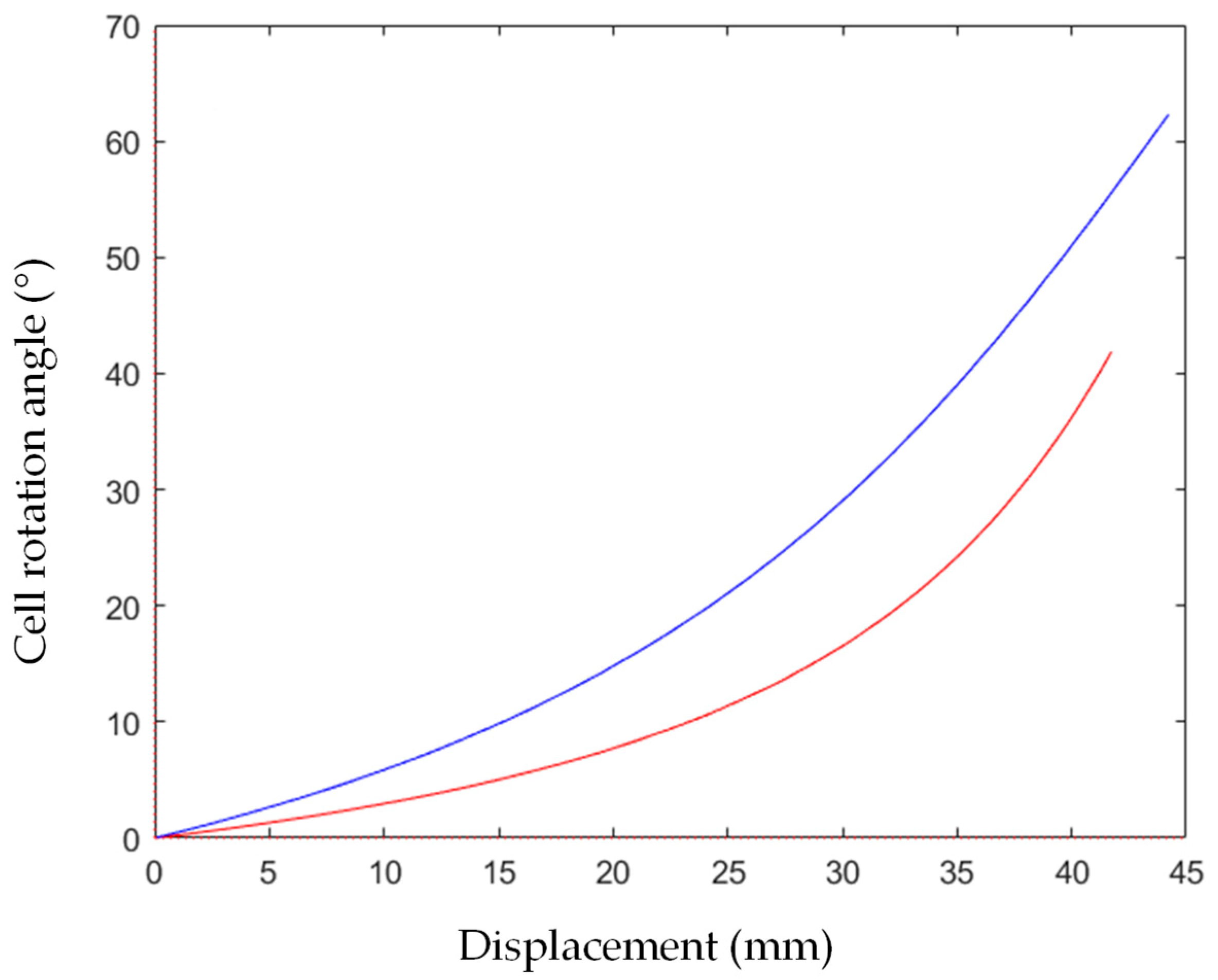
| Alveolar diameter f (mm) | 9 |
| Density (kg/m3) | 30–40 |
| Strength at stabilized compression (MPa) | 1.4–1.9 |
| Young modulus (GPa) | 70 |
| Shear modulus (GPa) | 20 |
| Maximum normal stress after linear stage (Peak stress) | |
| Average normal stress (Plateau stress) | |
| Energy absorption efficiency | |
| Strain (e*) corresponding to maximum energy efficiency | |
| Absorbed energy | |
| Maximum shear stress |
| Sample # | |||||
|---|---|---|---|---|---|
| 2 | 1.80 | 0.98 | 0.65 | 0.68 | 0.67 |
| 3 | 1.96 | 0.93 | 0.62 | 0.65 | 0.60 |
| Sample # | |||||
|---|---|---|---|---|---|
| 1 | 1.07 | 0.94 | 0.79 | 0.76 | 0.71 |
| 4 | 1.03 | 0.93 | 0.72 | 0.77 | 0.72 |
| Sample # | |||||
|---|---|---|---|---|---|
| 5 | 1.01 | 0.76 | 0.87 | 0.77 | 0.59 |
| 6 | 0.93 | 0.69 | 0.85 | 0.81 | 0.56 |
| Sample 0° | |||||
|---|---|---|---|---|---|
| 2 | 1.80 | 0.98 | 0.65 | 0.68 | 0.67 |
| 3 | 1.96 | 0.93 | 0.62 | 0.65 | 0.60 |
| Sample 15° | |||||
| 1 | 1.07 | 0.94 | 0.79 | 0.76 | 0.71 |
| 4 | 1.03 | 0.93 | 0.72 | 0.77 | 0.72 |
| Sample 25° | |||||
| 5 | 1.01 | 0.76 | 0.87 | 0.77 | 0.59 |
| 6 | 0.93 | 0.69 | 0.85 | 0.81 | 0.56 |
Disclaimer/Publisher’s Note: The statements, opinions and data contained in all publications are solely those of the individual author(s) and contributor(s) and not of MDPI and/or the editor(s). MDPI and/or the editor(s) disclaim responsibility for any injury to people or property resulting from any ideas, methods, instructions or products referred to in the content. |
© 2023 by the authors. Licensee MDPI, Basel, Switzerland. This article is an open access article distributed under the terms and conditions of the Creative Commons Attribution (CC BY) license (https://creativecommons.org/licenses/by/4.0/).
Share and Cite
Arquilla, G.; Ceci, A.; Costanza, G.; Tata, M.E. Effect of the Load Application Angle on the Compressive Behavior of Al Honeycomb under Combined Normal–Shear Stress. Materials 2023, 16, 5462. https://doi.org/10.3390/ma16155462
Arquilla G, Ceci A, Costanza G, Tata ME. Effect of the Load Application Angle on the Compressive Behavior of Al Honeycomb under Combined Normal–Shear Stress. Materials. 2023; 16(15):5462. https://doi.org/10.3390/ma16155462
Chicago/Turabian StyleArquilla, Giulia, Alessandra Ceci, Girolamo Costanza, and Maria Elisa Tata. 2023. "Effect of the Load Application Angle on the Compressive Behavior of Al Honeycomb under Combined Normal–Shear Stress" Materials 16, no. 15: 5462. https://doi.org/10.3390/ma16155462





